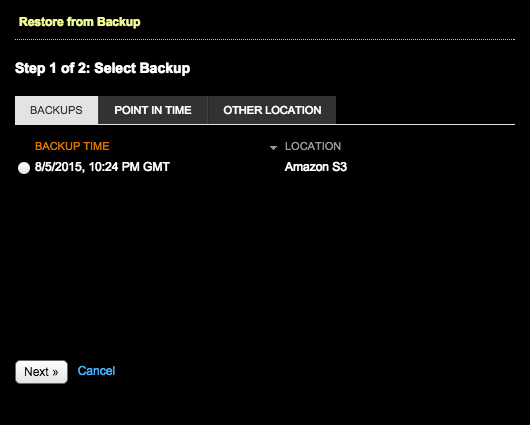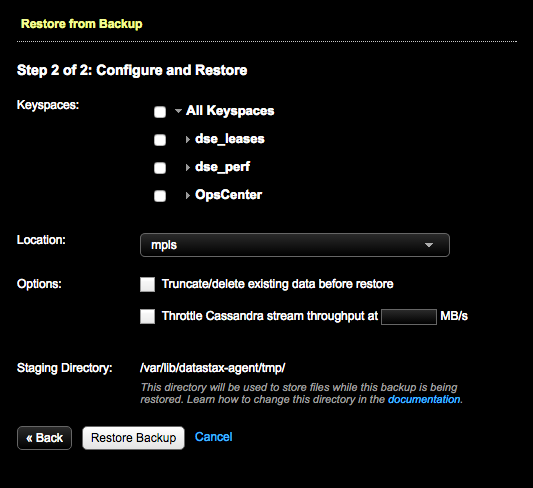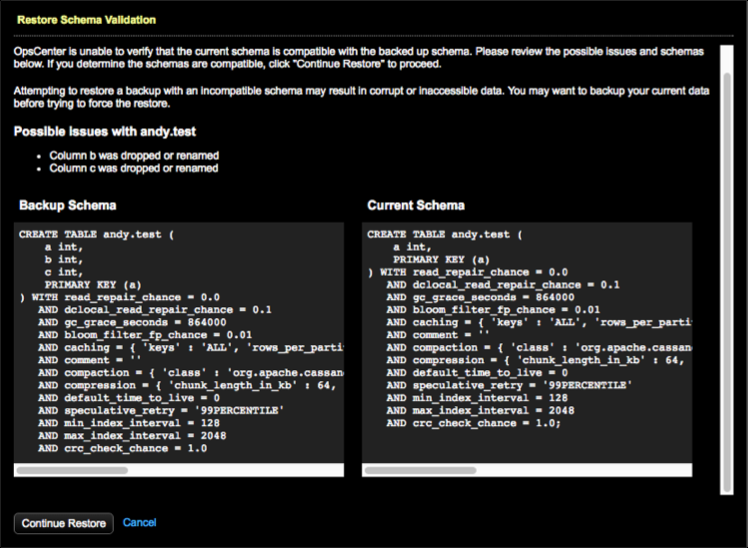Clone cluster data from one DSE cluster to another using the Restore Backup feature
in OpsCenter. This workflow requires the source and target clusters to both be managed by
the same OpsCenter instance.
Clone cluster data from one DSE cluster to another using the Restore Backup feature
in OpsCenter. This workflow requires the source and target clusters to both be managed
by the same OpsCenter instance.
Prerequisites
To clone the cluster data, there must be an existing backup of the cluster to a Local
FS or an Amazon S3 location. See adding
a backup location.
Note: Cloning
encrypted tables
to a different cluster does not work unless the encryption keys are identical, which
is typically not the case.
Important: The Backup Service requires control over the data and structure of its
destination locations. The AWS S3 bucket and the Local file system destinations must be
dedicated for use only by OpsCenter. Any additional directories or files in those
destinations can prevent the Backup Service from properly conducting a Backup or Restore
operation.
Procedure
-
Click the source .
-
Click the Details link for the Backup Service.
-
In the Activity tab, click Restore Backup.
The Restore from Backup dialog appears.
-
In the Backups tab, select the backup that contains the
data you want to clone and click Next.
-
Select the tables included in the backup you want to restore. Click the
keyspace name to include all the tables in the keyspace. Click All
Keyspaces to restore all the keyspaces.
To select only specific tables, expand the keyspace name and select the
tables.
Note: Keep the following caveats in mind when creating and restoring backups:
- Restoring a snapshot that contains only the system keyspace is not allowed. There must be
both system and non-system keyspaces, or only non-system keyspaces in the snapshot you want to
restore.
- Restoring a snapshot that does not contain a table definition is not allowed.
- Restoring a snapshot to a location with insufficient disk space fails. The Restore
Report indicates which nodes do not have sufficient space and how much space is necessary for a
successful restore. For more information and tips for preventative measures, see Monitoring sufficient disk space for restoring
backups.
-
Under Location, select the target cluster for the
restored data. Select a different cluster than the one that was backed up to
clone the data to the cluster.
The Location list is only available when there are
multiple clusters and both clusters are managed by the same instance of
OpsCenter.
-
To remove the existing keyspace data before the data is restored, select
Truncate/delete existing data before restore. This
completely removes any updated data in the cluster for the keyspaces you are
restoring.
-
To prevent overloading the network, set a maximum transfer rate for the
restore. Select Throttle stream throughput at ____ MB and
set the maximum MB per second.
-
Change the staging directory if necessary by setting
the
backup_staging_directory configuration option in
address.yaml.
-
Click Restore Backup.
-
Click Start Restore to confirm when prompted.
If the pre-restore checks detected schema differences that could not
automatically be validated, the Restore Schema Validation dialog appears.
Possible issues are listed and a comparison of the backup and current schema are
presented side-by-side.
-
Review the information to determine what adjustments if any need to be made to
the current schema:
Results
The details and progress of the restore operation are displayed in a progress
dialog, and also appear in the Backup Activity of the target
cluster. If you close the progress dialog, track the progress and status of the
restore in the target cluster's Backup Activity
section.
The progress and details of the restore
operation are displayed in the Restore Report.



